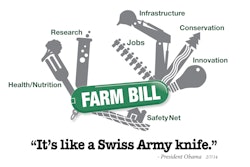
经过8年强劲,农场盈利孔蒂nues to be pressured by increases in supply relative to domestic demand and a strong dollar that is putting pressure on export markets. With what looks to be a bumper crop on the way in 2016, crop prices will remain low relative to the farm boom years of 2007 to 2014. While lower grain prices certainly help profitability for livestock producers, they suffer some of the same supply and demand issues as crop producers and returns for most of the livestock sector are also under pressure. When farms feel pressure on profitability, that same pressure moves back up the chain through their input providers. And, grain handlers may feel the profitability pressure as well, as farmers search ever harder for the best possible markets for their grain. In the current environment, farm input volumes may decline and competitive pressures intensify — forcing feed and grain firms to explore their own cost reduction strategies to meet profit targets.
Relative to periods when volumes are growing, margins are strong, and profitability is well into the black, the current down cycle in agriculture will test the mettle of managers who have to get both creative and tough to balance the need to maintain and deepen customer relationships while cutting their own cost of doing business. At the same time, the old adage “never waste a good crisis” applies — competitive pressures and the negative impact on profitability also gives managers “cover” to make moves that perhaps were needed but not so easy to implement in better times. Such a challenging environment also may create interesting strategic opportunities as competitors make their own decisions about how they’ll weather this down cycle in agriculture. In this article we will take a look at strategic cost management and some key issues to think about as you batten down the hatches to ride out the current profitability storm.
Strategic moves
It’s easy to go straight to the tactical when you start thinking about cost management. Managing overtime, seasonal labor, repairs and maintenance, training expenses, etc. all jump immediately to mind as areas to trim to boost profitability. However, a more strategic approach to cost management requires the feed and grain manager to step back and look at the full business in its broadest sense first. It may well be that one or two big, strategic moves may do more for lowering your cost of doing business than any amount of tinkering with operating costs.
Start by exploring the basic structure of your business including your locations and business segments. Perhaps you have been keeping a particular location open because the volume was at least generating breakeven profitability in better times or was serving some customers at a bit higher level than they might be served through a different location. The current environment may mean that such a location simply must be closed or operated as a part-time satellite rather than remain open full-time. While selling such a move to a customer base or a cooperative board may have been impossible in better times, the current environment may make it easier for customers/board members to understand why the move was/is necessary. (At the very broadest sense, a strategic approach to cost management may include mergers or acquisitions, but we will leave that area to a future column.)
Likewise, reviewing business segments is an important element of strategic cost management. Perhaps you have a line of business or a business segment that has been marginally profitable for a while but generated at least some goodwill/volume, so you remained in the segment/line. The current business environment makes “nice to have” lines of business very costly. It may be time to refocus on your core business and dump product lines/segments that just are not pulling their weight.
Finally, consider the processes you use to manage your business and whether or not it might be possible to consolidate or restructure functions or potentially even outsource them to a third party. Perhaps you have accounting capacity at every branch and a more centralized model for accounting services might enable you to reduce the total cost of your accounting function. Likewise, perhaps a salesperson might be shared between two branches or maybe your risk management could be more centralized. The point is to look at your business holistically and explore areas where centralizing activity might drive down cost without materially reducing service.
Outsourcing may be a way to offload activities that are not core for your business. Even accounting functions like payroll can be outsourced — as can trucking, employee training, and more. Certainly you have to understand what your own competitive advantage is — that’s not something you want to outsource. At the same time, thinking creatively may allow you to find a lower cost provider for something you’re currently in-sourcing. Outsourcing can be tricky; go down this path with both eyes open. There are plenty of stories where outsourcing sounded like a good idea, but the outsource supplier simply was not able to deliver at a required level or at a cost level that was satisfactory.
Tactical areas
Labor:Labor is the largest single cost for most feed and grain organizations, and it gets obvious attention in any cost management exercise. At the same time, labor is typically at the center of a feed and grain organization’s competitive advantage. So, you have to balance the need to cut cost with the need to protect and invest in your firm’s most important resource. Areas like watching hours worked and managing overtime get obvious attention. Use of seasonal labor is another area of focus. Getting creative here is important: Managing labor costs is not just about directly managing hours or head count. It may be that through better use of marketing and sales programs you may be able to help better manage your labor cost through more efficient scheduling, getting into the fields earlier, or off-season work etc., and avoid those extended runs of high overtime. However, we know agriculture is a seasonal business and all the planning that a manager does can’t change a compressed application or harvest season due to weather challenges. But thinking about how the firm’s marketing and sales policies affect labor utilization is much more important in a difficult business environment.
Such a tough environment may also present opportunities to trim your labor force. If you have some low performers, a period of tight profitability presents an opportunity to make hard calls that again may have been more difficult for the broader group to understand in better times. At the same time, pressure on competitors may create opportunities to actually pick up talent as other organizations make their own labor management decisions to remain profitable.
One important point here — make sure you know the employees you just can’t afford to lose and continue to invest in them even during challenging times. All experienced feed and grain managers know that agriculture is a cyclical industry. We go through these difficult periods and at some point we will come out of them. And, you want to make sure you have the best team possible when we do. This may mean continuing to invest in training, perks, compensation, etc. for those very best employees. In addition, these employees are typically going to be your very best source for ideas on how to manage costs in a tough environment, and you certainly don’t want to hand them to a competitor!
Equipment:Repairs and maintenance are typically large operating costs for feed and grain organizations. And, challenging economic times mean even closer scrutiny of repair and maintenance expenses. Like labor there’s always a trade-off: Skimping on repairs and maintenance may save a few dollars in the short run but could lead to catastrophic failure of a piece of equipment at a crucial time in season, costing you much more than the ongoing repair and maintenance might have. Be very deliberate about those repair and maintenance costs that you just must incur to keep your equipment and facility safe and operational and those investments which may be possible to defer.
Like labor you may be able to dump some older equipment that is just costing too much to operate during a downturn. Slower periods may also lead to deals on equipment that make replacement much more affordable for the feed and grain firm that has funds available. In addition, you can potentially pick up some equipment from competitors who are doing their own strategic cost management.
Other ideas:One important point in any strategic cost management exercise is to use your employees and engage them in the cost management process. Ask them to help you identify areas where cost savings are possible and where there may be better ways to do things. Likewise, make sure you “pressure test” any operational ideas you may have for cutting costs. It’s amazing how many ideas can come down from top management that sound really good in theory, but have real unintended consequences when line employees attempt to implement them. Don’t make those same mistakes and make sure you get feedback on operational ideas before unintended consequences torpedo your plan.
“小钱精明,大钱尤其敏感oolish” cost cuts. Some cost reductions may save you a little money but may cost you money in the longer run. As a simple example, an employee event that your entire team looks forward to annually requires an investment to fund the activity. Canceling the event might save some money in the short run but may undermine morale in a significant way. It also may send the message that the company is really struggling. All cost cuts have some impact and as one savvy manager once said “Every inefficiency has its constituency.” That said, don’t get caught cutting something that saves you a few dollars but undermines employee morale or customer service in unintended ways.
Finally, any strategic cost management exercise must include a good communications plan. Things get tight, employees get nervous, customers get sensitive, and every action you take is under the microscope. If you don’t communicate clearly what’s going on and why, employees will assume the worst. We see this too many times — when cost cuts happen with little explanation, the rumor mill kicks into high gear. Likewise a cost-cutting move such as closing a branch facility can create wild stories in the marketplace. Get ahead of these decisions and talk to the people and/or the customers involved to help them understand what you’re doing and why, so as to bring them onboard. We’ve written about change management before and certainly strategic cost management is change management!
Upshot
Managing through the current down cycle in agriculture will challenge feed and grain managers. It will also create an opportunity for a thoughtful strategic cost management program which cleans up the business in ways that trim the costs while protecting your feed and grain firm’s competitive advantage. (If you want to read more on strategic cost management, you might check out this article:http://www.bain.com/publications/articles/cost-cutting-withno-regrets.aspx).
In the process, resources may be freed up to take advantage of some of the opportunities that a challenging market always creates. A feed and grain business that has been savvy with its cost management program during a downturn will enter the next upswing well positioned to capitalize on increased volumes and lowered margin pressures. And, that is something to look forward to ...





















